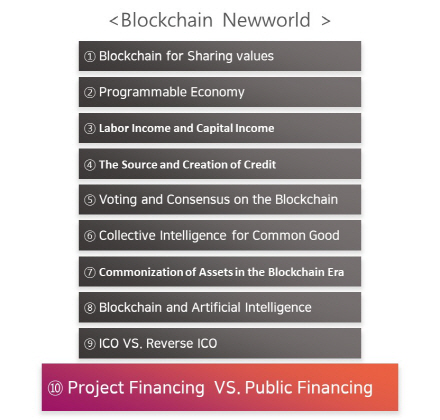

In the last article, I talked about ICO which is a way to fund a blockchain project. In this article, which is the last installment of the series, I am going to explain how the blockchain economy differs from the traditional economical system by comparing public financing and project financing which is another way to fund a project.
The word ‘project financing’ became a household name when the chain-reaction bankruptcy of saving banks was covered by the media day and night a few years ago and project financing was fingered as the major culprit. The dictionary definition of project financing is “financing where a lender provides a loan secured by the profitability and projected cash flows of the project rather than the assets or creditworthiness of its borrower and the principle is paid from cash flow generated from the project. Project financing is usually used to fund a social infrastructure project or a large-scale construction project.
One of the major characteristics of project financing is that the financial institution becomes the creditor as well as the stakeholder who is affected by the project‘s success. If the project they funded succeeds, the ROI of the saving bank soars. When home sales sink, they are pushed to the edge of bankruptcy. Projects suitable for project financing are mostly large in scale and need a lot of money. So, typically a syndicate of financial institutions provides loans instead of a single bank. Project financing is often dubbed the essence of financial capitalism because of its innovative concept that financial institutions provide loans to a borrower based on potential for success regardless of the creditworthiness.
What if we apply the methodology of project financing to blockchain and the token economy? In this scenario, the blockchain mainnet takes the role of the financial institution which is a creditor and stakeholder at the same time. Projects that need large amounts of funds are selected by voting on the mainnet. The credit is created based on the votes, and loans are provided by issuing more coins. When the project is successfully completed, the profit becomes the common asset of the community and is shared among the participants. This is the concept of public financing that experimentally applies credit creation through participation, global financing through collective intelligence and commonization of assets to project financing.
For public financing to become a reality, a governance system should be in place to encourage decision-making and participation through voting. As I have explained a couple of times in my previous articles, the promises agreed upon by the community should be established as algorithms. Cryptocurrency is a community currency that cannot grow without the members, and the members will desert the community if their opinions are not sufficiently reflected. Thus, decisions can be justified only when they are made based on a majority vote, and the cryptocurrency can grow as a community currency based on that justification. The community-based cryptocurrency must guarantee the structure where majority members’ opinions can be reflected. For example, when you want to have a governance system that gives one vote to one person, you have to be able to identify each individual while protecting individual privacy of the person and ensure decentralized decision-making.
In public financing, the community suggests a project in accordance with the governance system; it suggests, reviews, and votes on the issuance of additional coins; it creates credit and maintains the system autonomously. In addition to the purposes and anticipated results, the public financing agendas proposed by the community include issuance size, base price at the time of issuance, allocation of issued coins, and distribution among the community members. This is the way for us, members of capitalist society, to take back the ”financial sovereignty.“
Through a series of 10 articles, I have reviewed blockchain and cryptocurrency from an economic and financial perspective rather than from a technical perspective. Blockchain is a state-of-the-art technology, but at the same time, it is a new financial system and new way the economy works that was introduced to deal with the absurdity of the new liberal economics. I hope you agree that blockchain is not the object of speculation, but a technology and methodology to bring innovation and changes. Blockchain and cryptocurrency should be seen as a new attempt at allowing each community members to have financial sovereignty, exercise their rights, take responsibilities, and share benefits by decentralizing the financial capitalism that have been solidified and forced by a few with power and privilege. I appreciate you taking the time to read my articles./Yezune Choi BOSCoin CEO
- Yezune Choi BOSCoin CEO








![비트코인 8만 8000달러선…주요 알트코인도 하락세[디센터 시황]](https://newsimg.sedaily.com/2025/12/15/2H1QMJVFUE_2_s.png)
![서클, 엑셀라 개발사 인수에도 AXL 하락…왜? [알트코인 포커스]](https://newsimg.sedaily.com/2025/12/16/2H1R4FE9UE_5_s.jpg)



![[단독]네이버파이낸셜, 해시드와 ‘코인 지갑’ 내달 선보인다](https://newsimg.sedaily.com/2025/11/25/2H0LB3A07Q_11_s.jpg)
![[단독]금융위 “공동검사 요구 과도”…스테이블코인 놓고 한은과 파열음](https://newsimg.sedaily.com/2025/11/24/2H0KUTU6OA_5_s.png)
![[단독] '은둔의 경영자' 송치형, 네이버와 합병 청사진 직접 밝힌다](https://newsimg.sedaily.com/2025/11/21/2H0JI570IZ_5_s.jpeg)








